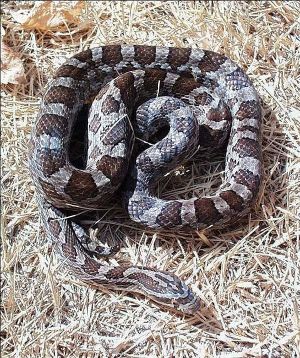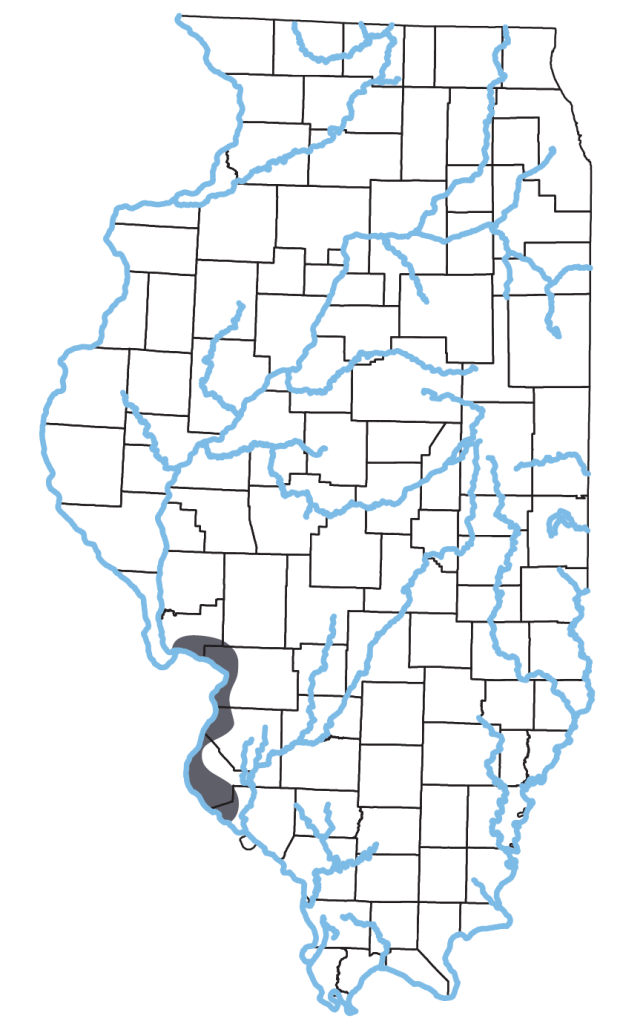Pantherophis emoryi (Baird and Girard, 1853)

Key Characters: Spear-shaped pattern on top of head; body scales keeled; anal plate divided.
Similar Species: Prairie Kingsnake, Eastern Milksnake, Eastern Foxsnake, Gray Ratsnake. See the Key to Snakes of Illinois for help with identification.
Subspecies: None recognized.
Description: Moderately large (up to 120 cm TL), blotched snake with gray or light brown back sporting 25 to 50 black-bordered, nearly square, dark brown or red-brown blotches. Tail with 8-20 dark spots or bands. Belly checkered black and white.
Habitat: Rocky, wooded hillsides, hill prairies, bluffs, and adjacent brushy fields.
Natural History: This nocturnal snake mates in April or May and lays 3-30 eggs a few weeks later. The young, 30-35 cm TL, hatch in August. Diet includes mammals, birds, and bird eggs. Medium-sized mammals and raptors are the main predators.
Distribution Notes: Found only along the Mississippi River bluffs from Jersey to Randolph counties. Probably no longer extant in St. Clair County due to urbanization.
Status: Threatened in Illinois, where its main threat is highway traffic.
Etymology: Pantherophis – ?; emoryi – (New Latin) in honor of William H. Emory (1811-1887)
Original Description: Baird S.F. & C. Girard. 1853. Catalogue of North American reptiles in the Museum of the Smithsonian Institution. Part I. Serpents. Smithsonian Misc, Coll. 2(5):172 pp.
Type Specimen: USNM, lost.
Type Locality: Howard Springs, Ellis County, Oklahoma.
Original Name: Scotophis emoryi Baird & Girard, 1853
Nomenclatural History: This species was first recorded in the Illinois literature by Davis & Rice, who used the name Coluber emoryi. Smith & Burger (1950. Additional noteworthy herpetological records for Illinois. Nat. Hist. Misc. 56:1-3) first documented the species from Illinois and used the name Elaphe laeta laeta (Boulenger, 1894). Smith (1961) listed it as Elaphe guttata emoryi as it was considered a subspecies of E. guttata at the time. Burbrink (2002. Phylogeographic analysis of the cornsnake (Elaphe guttata) complex as inferred from maximum likelihood and Bayesian analyses. Molecular Phylogenetics and Evolution. 25(3): 465-476) showed that Elaphe guttata is non-monophyletic and elevated E. emoryi to species status. Utiger et al. (2002. Molecular systematics and phylogeny of Old World and New World ratsnakes, Elaphe Auct., and related genera (Reptilia, Squamata, Colubridae). Russian Journal of Herpetology. 9 (2): 105-124) used molecular data to show that the genus Elaphe as recognized is paraphyletic and assigned the New World members of the genus to Pantherophis Fitzinger, 1843.


